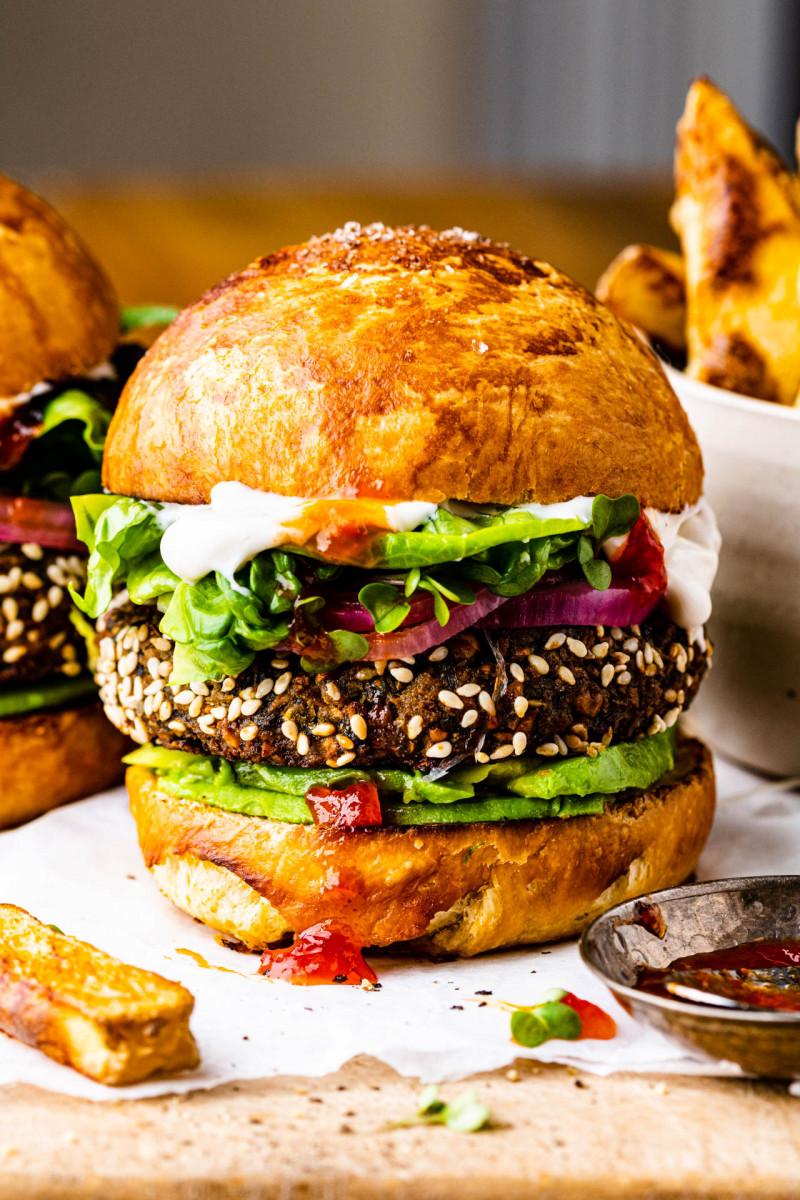
As courgette season (or zucchini season as it’s known for everyone but the English and the French) is upon us, I figured that a courgette recipe is in order. Enter this baked courgette burger!
It is the bee’s knees, I tell you. It’s moist on the inside and crispy on the outside. It comes together really quickly and with minimal fuss – there is no need to squeeze the moisture out of the courgettes at all. In fact, courgette’s moisture is very much needed in this particular recipe so roughly chopped courgette parties with all of the other ingredients in the food processor. They pulse and mingle together for a while – I am not sure what I am trying to do here…describing food in a new and exciting way for 800th time does get a big challenging at times, I won’t lie.
Anyway, these courgette burgers are legit. They don’t fall apart and they are full of flavour. The mixture freezes well too. I serve mine on my homemade brioche buns because I cannot get any decent vegan buns where I live, but hopefully you have some options where you live. I serve it with mayo, some pickles, a handful of salad leaves and sometimes a dollop of some spicy sauce. If we are really hungry, oven baked, handcut fries make an appearance too. I hope you’ll give these a try.
MORE ABOUT THE INGREDIENTS
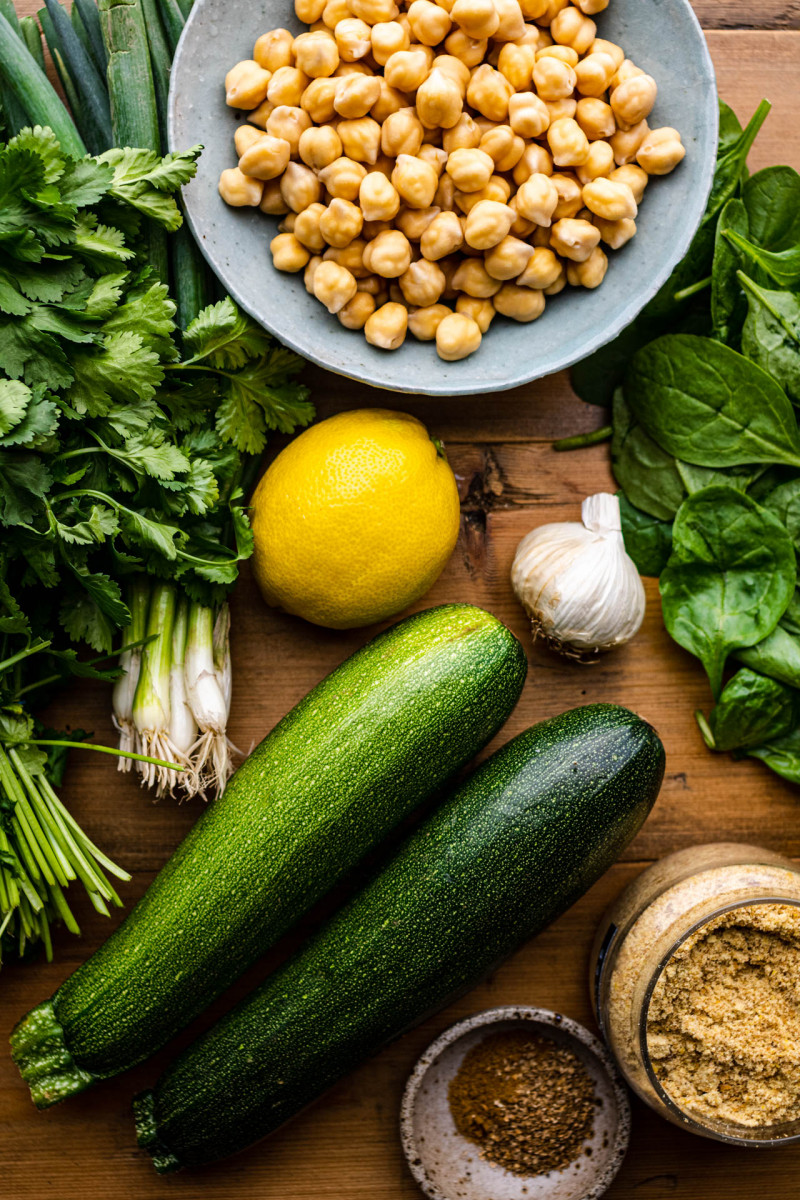
COURGETTE / ZUCCHINI: Courgette (known as zucchini in the US) is the main ingredient of these courgette burgers. Go for small/medium sized courgettes (they hold less water), chop it very roughly and put directly into your food processor. There is no need to squeeze the moisture out. The moisture is used to cook the raw chickpeas and to firm the burgers up as they bake.
CHICKPEAS: Chickpeas are one of the key ingredients of this simple courgette burger. For best texture that does not fall apart, use dry chickpeas soaked in plenty of water overnight, 24-48 hours is better. While you can make it with cooked chickpeas (you’ll need about 300 g or one and a half cups), cooked chickpea version is not as good in my opinion.
ONION, GARLIC: Alliums add flavour to these burgers, I opted for a bunch of spring onions (scallions) and garlic, but you could use a small or medium onion or a couple large shallots instead of spring onions. While you can add the aromatics directly to the food processor (after a rough chop), I recommend pan-frying them first to mellow their flavour. If you do use raw aromatics, be sure to add the oil you would use to pan-fry them directly to the food processor too.
GROUND FLAX: I add some ground flax to the burger mixture to help it bind, plus flax seeds are very nutritious so it’s always nice to include them in recipes like this. If you don’t have flax seeds, you could try ground chia seeds instead. I haven’t tried them in this recipe, but I have used them in similar recipes in the past to the same result.
BAKING POWDER: I like to add some baking powder to this burger mixture to help everything cook nicely and to stop the burgers from being too dense.
HERBS: I added a handful of fresh herbs for flavour. I opted for a mixture of parsley and coriander, but either of them on their own will work well too.
SPICES: Inspired by the falafel flavours, I added a bit of ground cumin and coriander for flavour. You can also add a pinch of chilli if you enjoy a bit of heat.
RICE FLOUR: I added rice flour to make these a little easier to shape, although the resulting mixture is still on the wet side and that is intentional. Do not add any extra flour as it will result in burgers that are dry on the inside.
SESAME SEEDS: I sprinkled the patties with some sesame seeds to make them pretty, you can skip them if you wish.
OLIVE OIL: I add a bit of oil to the burgers themselves and use some more to grease the patties as they are baking. Oil helps to keep these courgette burgers moist on the inside and ever so slightly crispy on the outside.
HOW TO MAKE IT?
1) MAKE BURGER MIXTURE
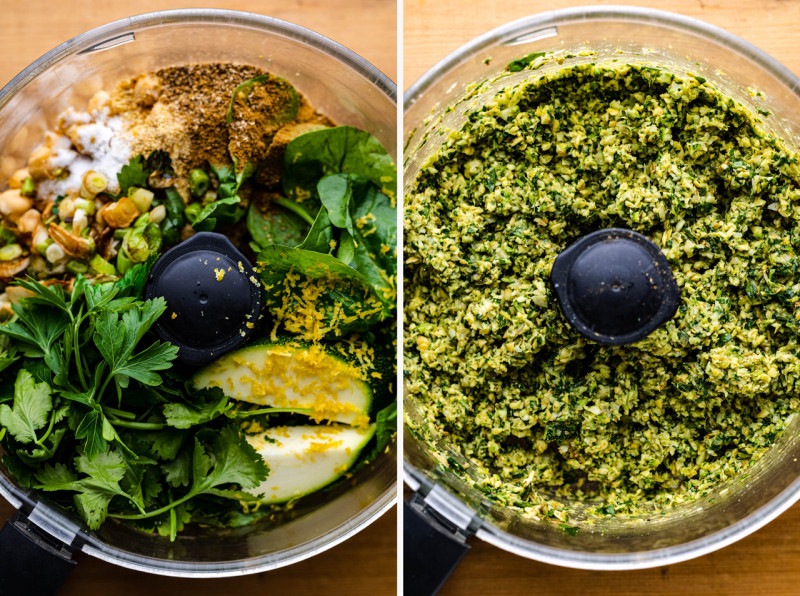
Before you start on these burgers, soak raw chickpeas in plenty of water at least the night before, longer if possible. Once your chickpeas have been soaking for at least 12 hours, drain them and add to the food processor with roughly chopped courgettes (zuccchini) and all of the other remaining burger components. Pulse until minced quite finely – see photo, but take care not to overmince. Chill the mixture in the fridge to enable you shape the burgers better.
2) SHAPE BURGERS
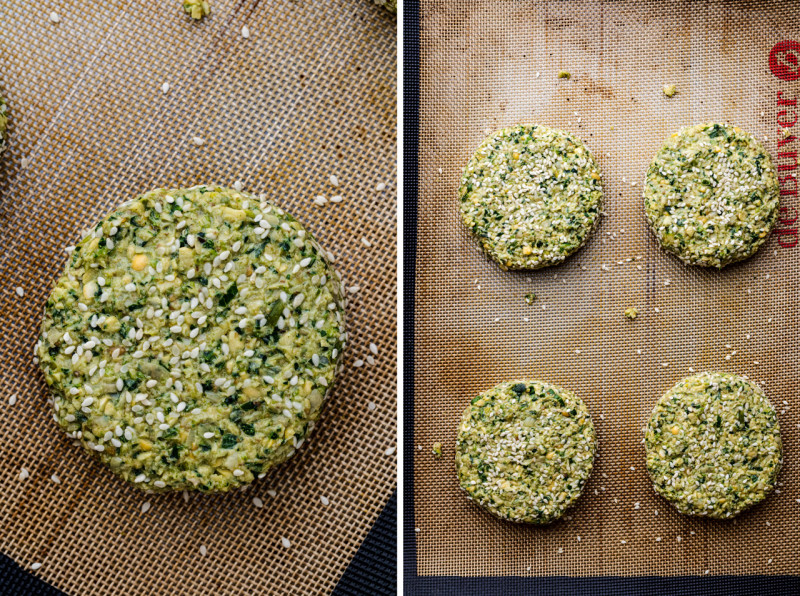
Shape the burgers using your hands into same size discs – mine were 8 cm / 3.1 inches across and about 15 mm / 0.6 inch tall, each weighing 100 g / 3.5 oz. The mixture is quite wet – that’s on purpose – but I found it easy enough to shape. If you struggle, mould the mixture inside a cookie cutter placed on a lined baking tray, then remove the cookie cutter gently and pat the burger into a more pleasing shape and apply some sesame seeds with your hands to the top and sides.
3) BAKE TILL PERFECTION
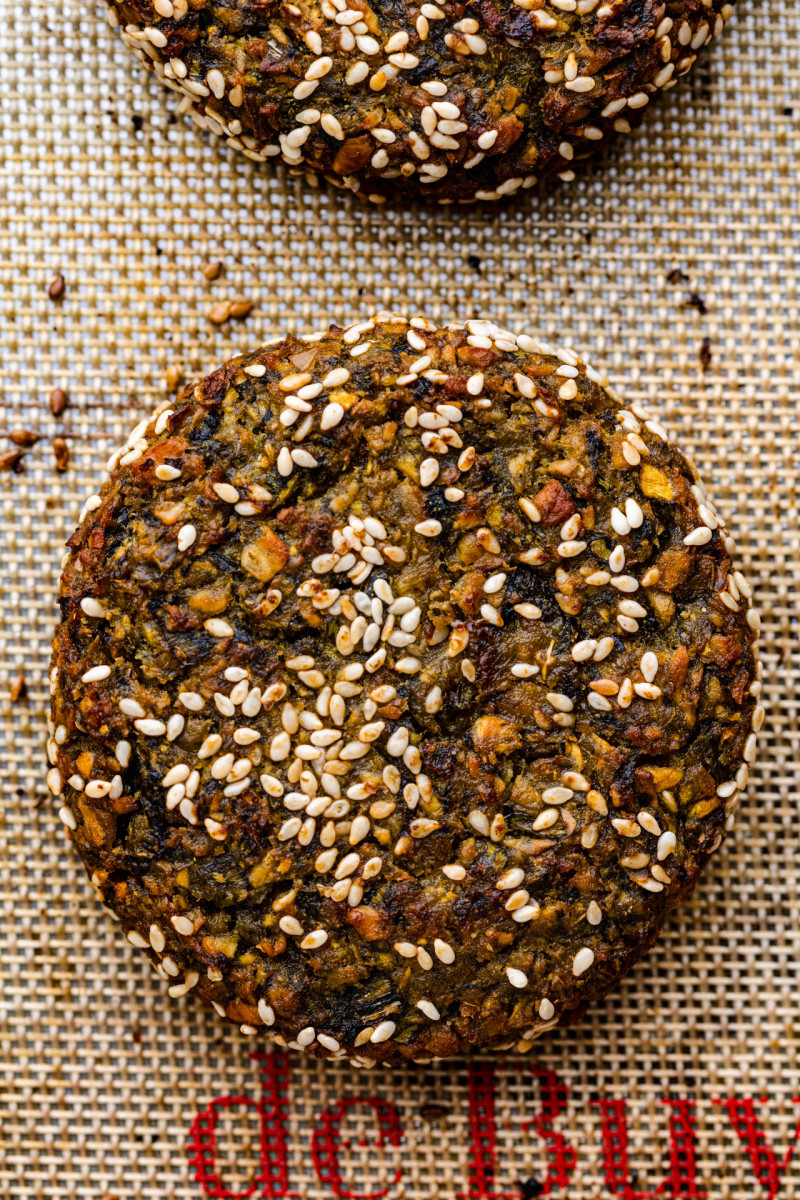
Bake till perfection. I initially bake them without any oil, once they start holding together, I gently prise them off the baking paper or silicone mat (using a palette knife) and brush them with a bit of oil. I continue baking them until firm and crispy.
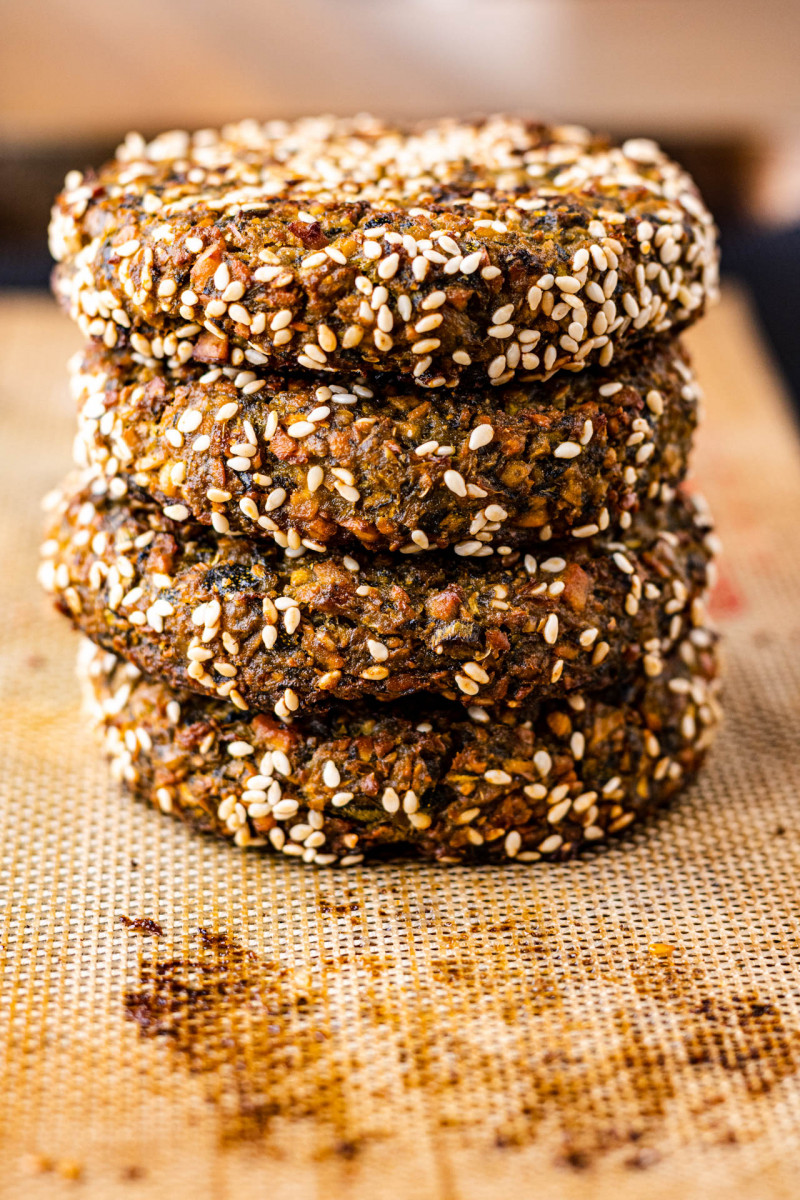

- 120 g / ¾ cup dry chickpeas*, soaked overnight (OR 300 g / 2 cups soaked)
- 60 ml / 4 tbsp olive oil, divided
- bunch of spring onions/scallions or small onion
- 3 garlic cloves, sliced
- 400 g / 14 oz courgette / zucchini (2 small)
- 1½ tsp tsp salt
- ½ tsp black pepper
- 2 tsp ground cumin and coriander
- 1 tsp baking powder
- zest 1-2 lemons (optional but recommended)
- 30 g / 1 oz fresh herbs (I used parsley and cilantro)
- 24 g / 4 tbsp ground flaxseeds
- 70 g / ½ cup rice flour (or other flour)
- sesame seeds, to coat (optional)
SUGGESTED BURGER COMPONENTS
- burger buns, shop-bought or homemade*
- ripe avocado, sliced
- little gem lettuce
- favourite pickles, I used quick pickled onion
- favourite condiments: vegan mayo, chilli jam / chilli sauce
- Soak dry chickpeas (that’s important) in plenty of water overnight or longer (up to 48 hours).
- Heat up 1½ tbsp of oil in a small frying pan. Once hot add sliced spring onions (white and light green parts only) and sliced garlic and pan fry on low heat until soft.
- Place chickpeas and roughly chopped courgette (zucchini) in a food processor. Add pan-fried aromatics and their oil. Add all other ingredients except for the remaining oil. Pulse until finely ground up (chickpeas should be the size of bulgur wheat – see photo in the post).
- Transfer the mixture to a mixing bowl and chill in the fridge for a couple of hours to firm up. You could also freeze the mixture at this point.
- Heat up the oven to 200° C / 390° F and line a baking tray with a piece of baking paper or use a silicone mat. Prepare a plate of sesame seeds (optional), a brush and a small bowl with approx. 2 tbsp of olive oil.
- Using your hands, shape chilled mixture into patties – the mixture will be very wet, that’s intentional! You could also shape the mixture inside a cookie cutter laid on the tray, then lift the cookie cutter off gently. I made 8 patties measuring 8 cm / 3.1 inches across and about 15 mm / 0.6 inch tall, each weighing 100 g / 3.5 oz . You could also freeze them at this point.
- Stick some sesame seeds to the patties using your hands, then gently place them on the prepared baking tray and bake for 20 minutes.
- Take the tray out of the oven and increase the temperature to 220° C / 430° F. Gently prise the burgers off the tray with a palette knife. Remove the baking paper (if using a silicone mat you don’t need to remove it) so that the patties sit directly on the metal tray and grease both sides of each patty with oil (about 1 tsp per patty). Bake for 10 minutes.
- After 10 minutes, flip again, brush with oil and bake for another 5-10 minutes (35-40 minutes total) – until the patties firm up. Allow them to cool down a little after removing from the oven as they will be fragile when hot.
- Assemble the burgers as per your preference. I like to toast my burger buns, then have a few slices of avocado at the bottom, followed by the burger patty, pickles, lettuce and mayo and chilli jam on the top half of the bun. Consume straight away, these are best straight after baking.
*BUNS: If you like the look of my buns 😉 , I made them following this recipe.